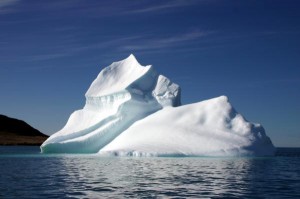Catlin Arctic Survey: Changes to Ocean Currents
 The 2011 Catlin Arctic Survey, sponsored by Bermuda-based (re)insurer Catlin, will focus on evolving conditions in the Arctic Ocean that could cause changes in ocean currents that influence the prevailing climate of Europe and the East Coast of North America.
The 2011 Catlin Arctic Survey, sponsored by Bermuda-based (re)insurer Catlin, will focus on evolving conditions in the Arctic Ocean that could cause changes in ocean currents that influence the prevailing climate of Europe and the East Coast of North America.
This year’s Catlin Arctic Survey will begin in March when a team of polar explorers and scientists will take part in a 10-week expedition and research project to examine the surface layers of the Arctic Ocean.
The Catlin Arctic Survey team – which includes specialist explorers and leading oceanographers from the United States, Canada and the UK – will study changes to sea temperature, increased fresh water and ocean currents in the Arctic, one of the world’s most extreme environments.
The Catlin Arctic Survey is sponsored for the third consecutive year by Catlin Group Limited the international specialty insurer and reinsurer.
The Arctic Ocean plays a vital role in driving ocean currents globally. Research scientists speculate that warming Arctic waters combined with increased levels of fresh water from melting ice sheets, ice caps and glaciers could radically unbalance the processes which sustain the most significant of these currents – what is known as ‘thermohaline circulation’.
These major currents carry heat and nutrients around the world’s oceans. Any change to conditions influencing these ocean currents could have impacts far away from the Arctic. For example, the climate in portions of the UK and Europe could cool, leading to increased snowfall in winters, while the frequency and intensity of severe storms – including hurricanes and tornadoes – could increase in the eastern portion of the US. Monsoon patterns could change in Africa and Asia.
The 2011 Catlin Arctic Survey consists of two initiatives:
- An international team of scientists will gather data and conduct research from the Catlin Ice Base, a unique research station located on the sea ice at the edge of the Arctic Ocean in Canada; and
- A team of Arctic explorers will undertake two separate missions to gather additional data: across Prince Gustav Adolf Sea and from the North Geographic Pole towards Greenland. The explorers will collect data from the murky depths below the frozen ocean surface as part of a research project devised by Dr. Simon Boxall of the National Oceanography Centre in Southampton, UK.
Dr. Boxall said: “Catlin Arctic Survey 2011 will help us understand the process of ice melt and how quickly fresh water from melting ice is being taken away from the area. The first few metres of water, in particular, are critical for understanding the process of bottom-up ice melting, something that could accelerate Arctic ice melt and disrupt ocean circulation.”
Dr. Boxall said there is an immediate need for a better understanding of this little-researched process to inform out-of-date climate models. “The Arctic is changing faster than IPCC models forecast; over the last four years we have seen the surface area of Arctic ice decline to levels predicted for 2070,” Dr. Boxall explained. “If the ice continues to melt at its present rate, predictions made as recently as 2003 could happen 60 years earlier than expected – potentially precipitating changes to ocean currents sooner.”
At the mission’s floating Catlin Ice Base off Ellef Ringnes Island, US scientists from Old Dominion University in Norfolk, Virginia, will be investigating how organic material in fresh water near the surface of the ocean may be trapping heat from the sun, causing the upper ocean layers to warm.
Ice Base researcher Dr. Victoria Hill of Old Dominion said: “This is a very new area of research and this mechanism represents a key uncertainty in accurate modelling of ice thickness and upper ocean heat content.”
Professor Richard Zimmerman of the Bio-Optics Research Group at Old Dominion University said: “Overall, if these changes the Catlin Arctic Survey is investigating contribute to a lowering of the salt content of the North Atlantic, it could have a major impact on the entire planet – from significant temperature drops in Europe to intensified monsoons in Asia.”
“It may also impact weather patterns throughout North America, including a dramatic increase in the frequency and intensity of severe storms, including hurricanes and tornadoes across the eastern US. The combination of effects can produce extensive flooding, coastal erosion and damage to major infrastructure, including crops, homes, industrial sites and cities.”
Catlin Arctic Survey 2011 will also build on research begun in 2009 and 2010 into the thickness of sea ice and ocean acidification.
Leading polar explorer and Survey Director Pen Hadow said the unique nature of the Catlin Arctic Survey makes possible vital field research into the fast-changing state of the Arctic. “This type of science can only be done by or with the support of explorers. Ocean temperatures and salinity below the sea ice cannot be measured using satellites, the passage of ships disturbs the delicate layering under the sea ice, and submarines don’t travel close enough to measure the critical first 200 metres of water.”
Stephen Catlin, Chief Executive of Catlin Group Limited, said: “Ocean currents hold one of the keys to global weather patterns and ocean levels. As no one is 100 per cent sure how current changes in the Arctic could impact other regions of the world, we at Catlin are proud to sponsor scientific research to produce hard facts that will help us prepare for potential changes to our environment in the years ahead.”
Read More About
Category: All, Environment

